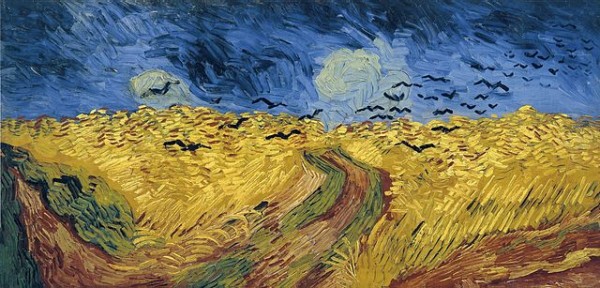
I’ve never been good at beauty. Yes, of course I can in some sense understand beauty – for instance could tell you the parts of a piece of literature that make it beautiful. But I usually don’t permit beauty to draw me out of myself – maybe because I’ve been pushed and pulled and pinned and boxed in so many times by mental illness that I experience my own passibility as fear – the drawing out effected by beauty is of a good kind, but that’s hard to accept when the stirrings of it feel like violence. Further of course, I know my own heart and wonder whether, if I permitted my heart to move, it would move appropriately. There is always the possibility of lust for the beautiful thing or person, of envy of beauty’s seemingly peaceful state, or a deep irrational destroying frustration with something or someone so lucky as to have escaped pain – or at the very least to have somehow transcended it.
Conversely, what attracts me to people, things, and art alike are the haunted places, the places where there is yearning, tenderness, fear, pain, loneliness, and finally love. The love I am drawn to in hope – hope that it can be me someday. Likewise the tenderness. But the rest are a mirror of myself, and I seek them out as spaces where I can hear and be heard, where the darkness unnamable is not perhaps named, but at least felt – or felt to be felt – mutually. Of course, to affirm that we can simply feel each other’s pain apart from the mediation of Christ’s body is a dangerous mistake, a disregard of the particularity of others’ wounds; “I know how you feel” is a deadly phrase whenever detached from the metaphysics of the suffering Christ, whose suffering is known to us, yet also more unknown than known. Still, all this being said, sufferers can sit in the apophatic darkness and converse – and hold each others’ hands – and discover that they are somehow not alone, even if they will never fully know the depth of the other’s pain. It is this that I seek from most of my encounters, and since beauty, or at least the usual type of beauty, is not often participant in this sometimes horrific conversation, it is something I reckon little with.
And yet recently I have begun to be drawn to beauty through what I can only call a kind of empathy, and this by reading Josef Pieper’s Leisure: The Basis of Culture. Now this book of course is primarily about leisure, but as Pieper works out his argument, his definition of leisure is not so much fixed as it is fluid, a space apart from the utilitarian world of work that is the backdrop against which our world evaluates most things. Primarily marked by the evocation of wonder, this space is the sphere proper to various human experiences including worship and beauty and contemplation and the liberal arts, where what is encountered is marked by a particular kind of givenness rather than by a utilitarian justification. Yet in the workaday world, many of these truly free and freeing pursuits will be maligned and discarded as useless. And it is in this way that a certain kind of empathetic approach to beauty has been growing in me – because I know too well what it is to be useless when measured by usual utilitarian standards.
I know, that is, the uselessness effected by mental illness. I know some will quibble with my assertion of myself as such, and I know there are some who have it a lot worse off than I – I at least have the opportunity and wherewithal to teach in my field part time. Still, there is a deep pain when I see my peers making exciting contributions in their fields and generally doing amazing things while I watch myself spend most of my energy trying to survive or bury any spark of an idea I have under self-hatred, self-doubt, fear of rejection, perfectionism, or obsession, and fail over and over again to get things done, even when I have promised them to others. By any reckoning based on a utilitarian model – the model increasingly dominating the academic world as the university abandons the idea of a liberal arts education and adopts the value sets associated with what Pieper calls servile work – I am at the bottom of things, a failure. But even so there is still it seems a space left to me, the space of leisure Pieper has carved out of the workaday world. For this space is not based on utility and completion time, but a particular kind of openness to reality – and this space indeed is what I am forced many times to inhabit given my circumstances as a mentally ill academic. I am forced to sit and watch – receive – as the world I work on and think about passes me by, and only sometimes I am given the grace to actually articulate what I see and to be useful academically. Still, I cannot always predict when that will be, so mostly I just have to be content with this safe but frustratingly useless haven of grace beyond work, where I can receive and am received, no strings attached. And realizing this caused me to think about the fragile vulnerability of beauty.
By this I mean that the beautiful thing, insofar as it is maligned and hated and deemed useless, occupies in many ways the same space occupied by wounded and broken things, things that are of no use to the servile world – for both must occupy in their passivity the extra-servile space of Sabbath. To be sure, it is for different reasons – beauty occupies this space because it is by definition extra-utilitarian, while the wounded occupy this space and keep the Sabbath precisely because they can’t work – but it is interesting thinking about the ways they share the same space, the way the tears of the broken water the feet of the beautiful. There are ways perhaps it makes me even pity beauty – feel for it as a creature similarly alienated from work and its merits, but for that very reason also, like me, the recipient of grace. For pity too is a form of grace.
Of course, all that I am saying here has been much more elegantly caught up in a single image, and that from a particular Anglo-Saxon poem, The Dream of the Rood. In it, the poem’s speaker encounters a cross that seems to be constantly changing its outward appearance, now adorned with gold and gems, now effectively exhibiting stigmata and the other tortures of Christ. Later we learn that the cross is a sign, a beacon that leads one to heaven, and it is perhaps precisely for the reason explored in this post, the close proximity of the beauty and the suffering – one outside the aegis of the sæculum because receptive of extra-worldly grace, and the other outside because what is wounded and dying has no choice but to be reliant on given grace. The constantly changing cross is a hinge, drawing the wounded up into its extra-worldly wounds fused immediately with all that is beatific – the bush burns, but the flame does not devour; beauty and suffering kiss where the fire and the rose are one.











